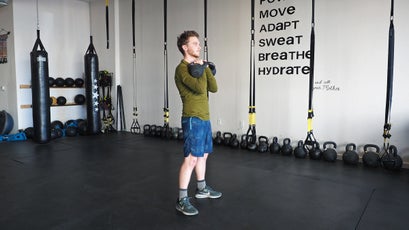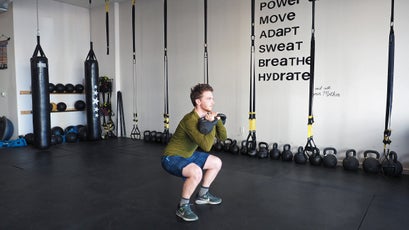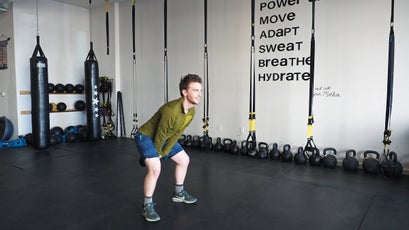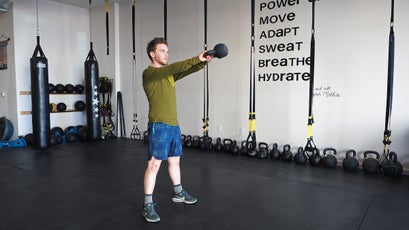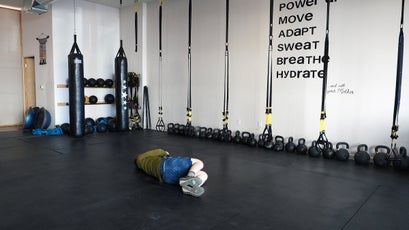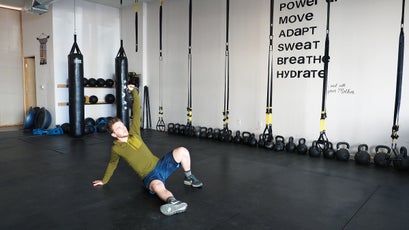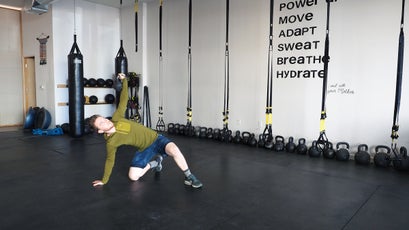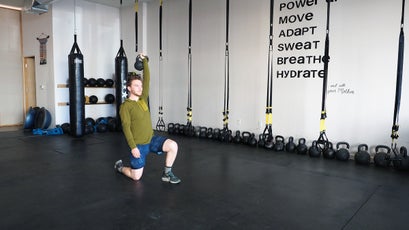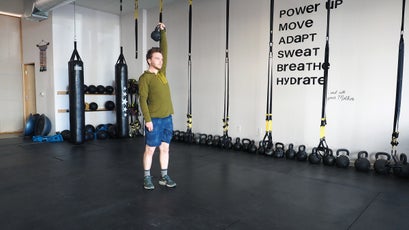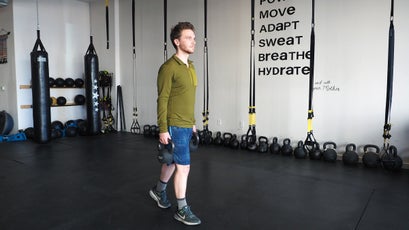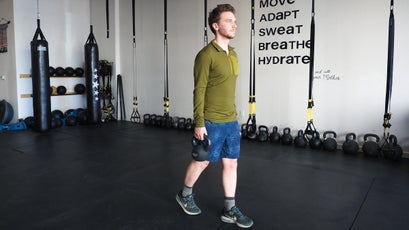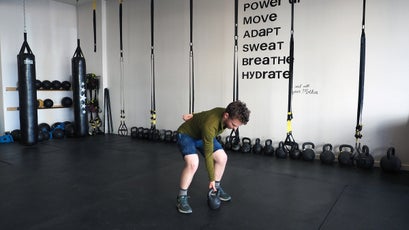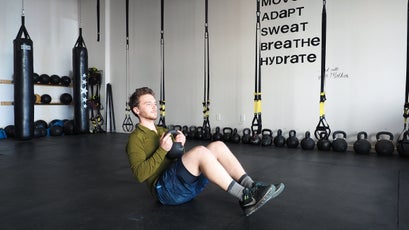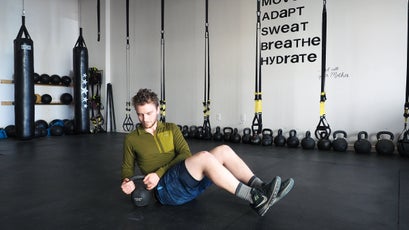As far as exercise equipment goes, a kettlebell is as simple as it gets: just a hunk of iron with a handle. And unlike complicated weight machines, kettlebells allow for compound, functional exercises, which work multiple joints and muscle groups together—including small stabilizers—to better mimic your movements in the mountains.
Most outdoor athletes, especially skiers, climbers, and hikers, spend a lot of time under tension, with your muscles loaded and engaged for long durations, says John Mark Seelig, a coach and the co-founder of Goat Training in Edwards, Colorado. Think about the leg burn that builds during a nonstop ski run, for example. Early in the season, the burn can be brutal. A little preseason strength and conditioning work will go a long way toward allowing you to link turns with style, top to bottom. “Kettlebells are an excellent training tool for that tension,” Seelig says. “Plus, for a lot of people, they’re more fun than machines and less intimidating than a barbell loaded with weight.”
Below, Seelig shares a full-body strength and conditioning workout using only kettlebells.
The Workout
If you’re in training mode, Seelig recommends doing this routine two to three times per week to build strength. Once your season is underway, dial it back to one to two times per week for maintenance. Consistency is key. For more of a strength workout to target muscle recruitment and growth, use heavier loads and fewer reps. For a conditioning workout to target the cardiovascular system, use lighter loads and higher reps.
Start with three sets of the first three exercises below. As your body adapts to the stress and gets stronger, gradually add more exercises into the routine and increase the number of sets. Choosing the correct weight can be tricky at first and might take some experimentation. “Whatever your rep scheme is, keep two reps in the tank,” Seelig says. If you’re aiming for ten reps, for example, you should be able to complete 12 before maxing out or losing form. Once an exercise begins to feel too easy—as in you have four or five reps left in the tank once you hit your target—up the weight.
Start with light loads until you master proper technique. As always, focus on form over volume. Stop as soon as your form breaks: bad form can lead to injury and means that you’re likely compensating with non-target muscle groups. When in doubt, have a certified trainer or coach walk you through the movements or assess your technique.
The Moves
Double Kettlebell Rack Squat (Kettlebell Front Squat)
What it does: Primarily strengthens the gluteus maximus and quadriceps and activates the core, upper back, chest, shoulders, and arms.
How to do it: Clean (lift) two kettlebells into the rack position—squat, hinge forward at the waist, and grab one in each hand with an overhand grip, like you would to start a kettlebell swing. Then, with straight arms, hike the weights up and behind your legs. As they swing forward, use the momentum to lift the weights to shoulder height and rotate them to balance on the backs of your forearms, with the handles seated in your palms. Keep your wrists straight and elbows tight to your body.
Stand tall with your feet hip-width apart or slightly wider and your toes facing forward or angled slightly out to the sides. Keep your chest and head high, pull your shoulders back and down, and engage your core muscles. Bend your knees and push back your hips to lower into a squat while keeping your back straight. Continue lowering until your thighs are parallel to the ground, or go lower if you have the hip and ankle mobility and can maintain good form. Push through your heels to stand up.
With any type of squat, good form is key to prevent injury and target the glutes—the primary muscle group used in this exercise. Keep your spine straight and your weight over your heels. (You should be able to wiggle your toes throughout the movement.) Your knees should track straight forward over your toes but not beyond, and they should not collapse inward at any time throughout the movement. (This is associated with knee pain.) If you cannot maintain adequate knee control, strengthen your hip abductors first.
Volume: Three to five sets of ten to 15 reps.
Kettlebell Swing (Russian Swing)
What it does: Improves strength and power in the posterior chain (the muscles on the backside of the body), particularly the glutes, hamstrings, and spinal erectors. This latter group is made up of long muscles, which run parallel to the spine and help straighten and rotate the back. Swings also train hip mobility and lumbar (lower back) stability.
How to do it: Stand in front of a kettlebell with your feet slightly wider than your shoulders, toes facing forward. Keep a slight bend in your knees, and without rounding your spine, hinge forward at your hips to reach down and grab the handle with both hands, using an overhand grip.
With straight arms, hike the weight, like a football, up and behind your legs. Then snap your hips forward, squeeze your glutes, and straighten your torso and knees to swing the weight up to shoulder level but no higher. At the top of the swing, your body should form a straight line from heel to head.
Let gravity swing the weight back through your legs as you reverse the movement. As the kettlebell swings back, soften your knees and hinge forward at the hips—without rounding your back—until your torso is nearly parallel to the floor. Immediately begin the next repetition.
This is not a squat but a hip-hinge movement. The power comes from the hip thrust. Keep a neutral spine throughout the movement, and be mindful to not overextend your back at the peak of the swing or squat too low on the return. Incorrect form can stress the lower back and will not target the right muscles.
Volume: Three to five sets of ten to 15 reps.
Kettlebell Turkish Get-Up
What it does: Strengthens just about everything—the quads, glutes, hamstrings, pecs, triceps, traps, deltoids, and core—through a functional movement pattern. “The Turkish get-up is one of the more technical kettlebell movements,” Seelig says. “But when done correctly, these are one of the best, because the whole body is involved.”
How to do it: This one’s complicated—a video might help. Lie on your right side on the floor next to a kettlebell. With your right arm, grasp the kettlebell with an underhand grip. Roll onto your back as you press the kettlebell straight up until your right elbow is fully extended. (You can use both hands for this press.) Bend your right knee and place your right foot flat on the floor. On your left side, stick your arm and leg out at 45-degree angles and press them into the floor for support.
Roll up onto your left elbow (engage and stack your shoulders), then fully sit up using your left hand and arm for support. Lift your hips off the ground, and sweep your left leg to a kneeling position underneath your hips. Come up off your arm so your torso is vertical. Pivot your left foot to square your hips and enter a lunge position. Then, stand and bring your feet together. Slowly reverse the movements exactly as you did them, and repeat. Complete all reps on one side before switching to the other.
Volume: Three to five sets of five to ten reps (each side).
Kettlebell Farmer’s Walk
What it does: Primarily strengthens the traps, deltoids, and core muscles and trains core and hip stability.
How to do it: Stand tall while holding a kettlebell in each hand with straight arms. Keep the weights at your sides, a couple inches away from your body so they don’t brush your legs. Hold your chest and head high, pull your shoulders back and down, and engage your core muscles. Then, walk forward, taking small steps.
Volume: Three to five sets of 50 to 100 feet.
Double Kettlebell Rack Split Squat
What it does: Primarily strengthens the quads and glutes and activates the calves, hamstrings, hip adductors, and core muscles for stabilization and balance.
How to do it: Clean two kettlebells into the rack position at shoulder height (as described above), and stand tall with your core engaged. Take a large step forward with one foot. (Closer feet will put more emphasis on the quads and less on the glutes, whereas a larger distance will put more emphasis on the glutes and less on the quads.) Then, sink your hips to lower into a squat until your front thigh is parallel to the floor. (Your rear knee should not touch down.) Push with both legs to stand up. Repeat all reps on one leg, and then switch sides. Maintain a straight and upward torso throughout the movement. Be mindful that your front knee does not move beyond your toes or collapse inward as you move.
To challenge your balance and make the exercise more difficult, do a Bulgarian split squat: the form is the same as above but with the top of your rear foot on a box or bench.
Volume: Three to five sets of ten to 15 reps (each side).
Kettlebell Overhead Press
What it does: Primarily strengthens the deltoids, as well as the triceps, traps, and rhomboids.
How to do it: Clean a kettlebell into the rack position. Stand tall, with your shoulders back and down, your core engaged, and your feet hip-width apart. Then, press the weight overhead until your arm is fully extended (palm facing forward), and slowly lower it back to the rack position at shoulder height. Repeat all reps on one arm, then switch. Keep your hand, wrist, and forearm in line and vertical throughout the movement. Be mindful to keep your shoulders level—if they dip to one side, the weight is likely too heavy for you.
Volume: Three to five sets of ten to 15 reps (each side).
Kettlebell Kayaker (Seated Russian Twist)
What it does: Targets the deep core muscles, the transverse abdominis, and the obliques through a counter-rotational movement.
How to do it: Sit on the floor with your knees bent to 90 degrees. Lift your feet a few inches and rock back slightly to balance on your sit bones. Then, with both hands, lift a kettlebell up and over your waist. Lightly touch the weight to the floor on one side, and repeat in the opposite direction. Rotate your shoulders to follow the weight, and resist any movement in your hips and legs. Continue shifting the kettlebell from side to side. Move slowly and in control. Keep your core engaged and your torso straight to protect your lower back.
Volume: Three to five sets of 15 to 20 reps.

